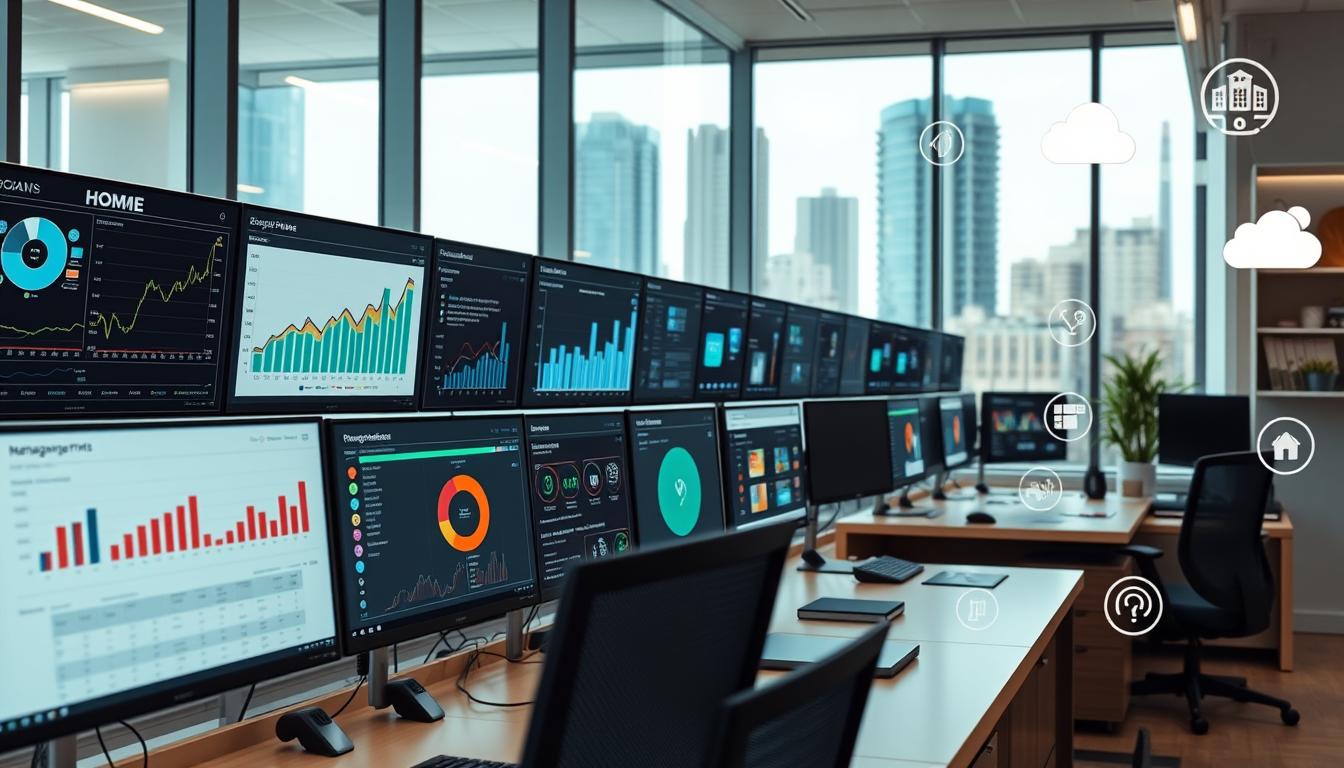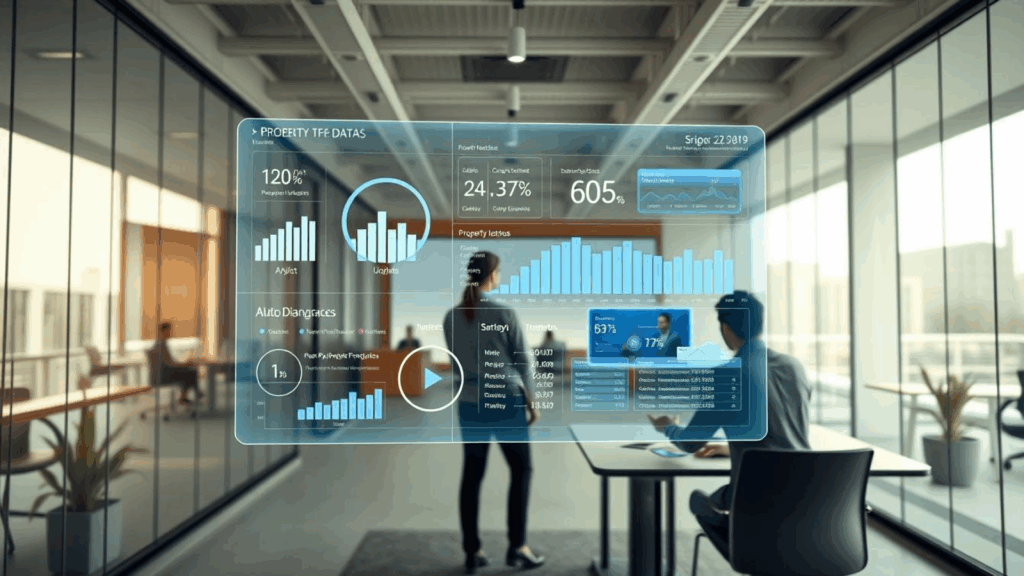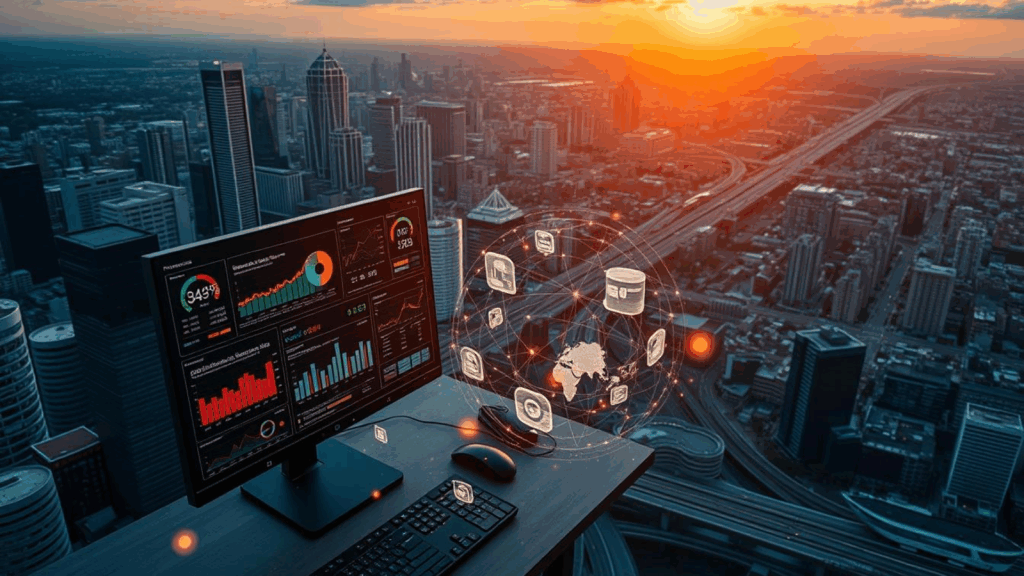In today’s fast-paced real estate industry, property managers are embracing technology to streamline operations and cut costs. Property management software offers a suite of tools to simplify daily tasks. This allows managers to focus on business growth and improving tenant satisfaction.
By integrating property management technology, real estate professionals can significantly reduce time spent on manual tasks. These software solutions provide a centralized platform for tracking important information and automating routine processes. This ensures data access from anywhere, saving time and reducing human error.
One of the key benefits of property management software is its ability to automate rent collection and payment processes. Features like online rent payments and automatic late fee calculations streamline the process. This ensures timely payments from tenants and reduces administrative burdens. Tenant screening processes are also streamlined, allowing for quick and thorough background checks and credit reports.
Key Takeaways
- Property management software automates routine tasks, saving time and reducing operational costs
- Centralized platforms allow for efficient tracking of important information and data access from anywhere
- Automated rent collection and payment processes ensure timely payments and reduce administrative burdens
- Streamlined tenant screening processes enable quick and thorough background checks and credit reports
- Property management technology simplifies financial reporting, maintenance management, and lease administration
The Benefits of Adopting Property Management Technology
In today’s fast-paced real estate market, property managers are turning to technology to streamline operations, reduce costs, and enhance efficiency. By adopting property management software, managers can tap into a range of benefits that drive business growth and tenant satisfaction. With the global property management software market projected to reach $50.19 billion by 2032, it’s clear that the demand for these solutions is on the rise.
One of the primary advantages of property management technology is cost savings. Over 50% of property managers have reported significant reductions in operating costs after implementing software systems. By automating tasks such as rent collection, maintenance tracking, and tenant screening, managers can minimize manual intervention and reduce operational inefficiencies. This not only saves time but also helps to improve accuracy and compliance, further contributing to cost savings.
Another key benefit of property management software is the ability to automate and streamline various processes. From financial operations to tenant communication, these systems centralize management capabilities, enhancing transparency and accountability. Automated rent collection reduces the time spent chasing payments and minimizes the risk of late or missed rents. Smart maintenance systems with 24/7 live bilingual support and remote monitoring enable faster issue resolution, benefiting both residents and property managers.
| Benefit | Impact |
|---|---|
| Cost Savings | 50%+ reduction in operating costs |
| Tenant Satisfaction | 81% increased satisfaction with properties using software |
| Streamlined Operations | Centralized management, enhanced transparency, and accountability |
| Automated Financial Operations | Time savings, improved accuracy, and compliance |
Property management technology also plays a crucial role in enhancing tenant satisfaction. A survey revealed that 81% of renters expressed increased satisfaction with properties utilizing management software. Features like virtual tours, smart amenities, and mobile applications contribute to a seamless and convenient tenant experience.
As property managers navigate the adoption of technology, it’s essential to consider factors such as the problem to be solved, expert assistance, pricing, value, implementation costs, and user-friendliness. By carefully evaluating these aspects, managers can select the ideal solution that delivers maximum efficiency gains for their team and drives overall business success in the ever-evolving real estate landscape.
Automating Rent Collection and Payment Processes
Property management technology is transforming how landlords collect rent and handle financial reports. With digital rent collection systems, tenants can pay rent online. This method saves time and reduces the hassle of traditional payment methods.
Automated reminders are a key feature of property management software. These reminders help avoid late payments by alerting tenants of due dates. They also offer online payment options.
Property management technology also simplifies financial reporting for landlords. It automatically compiles transactions and generates reports. This provides real-time insights into the property’s financial health. It helps spot issues and make informed decisions, saving time and reducing errors.
Automating rent collection and financial reporting helps landlords generate passive income more effectively. Modern tools allow secure payments from various sources. This increases tenant satisfaction and reduces turnover.
Using property management software for automating rent collection and payment processes improves efficiency and saves costs. It also enhances the experience for both landlords and tenants.
Streamlining Tenant Screening and Leasing
Property management technology is transforming the tenant screening and leasing landscape. It saves landlords a lot of time and money. Online tenant screening platforms enable quick background checks, credit scores, and rental history checks. This is a huge improvement over the days it used to take.
These digital tools eliminate the need for mailed paperwork. Tenants can input their information online, speeding up the decision-making process. This efficiency is crucial for landlords looking to fill vacancies quickly.
Digital lease agreements offer electronic signing and filing, reducing paperwork and the risk of lost documents. This streamlined process helps landlords fill vacancies faster. It minimizes downtime and maximizes income potential.
By adopting property management software with integrated online tenant screening and digital lease agreements, landlords can streamline their leasing processes. This attracts qualified tenants and leads to faster vacancy filling. These tools save time and offer a more efficient, organized approach to managing rental properties.
Simplifying Property Maintenance and Repair Management
Property management software is transforming how property managers manage maintenance and repairs. It saves time and cuts costs. Features like automated maintenance requests, digital inventory tracking, and preventive maintenance make processes smoother and more efficient.
Automated maintenance requests let tenants report issues online, which are then quickly sent to the right maintenance staff. This cuts down on the time wasted on phone calls or emails, speeding up responses.
Digital inventory tracking keeps tabs on supplies and parts, preventing shortages and ensuring repairs are done on time. It helps property managers manage maintenance needs effectively, avoiding costly delays.
Preventive maintenance is a crucial part of property management software. It helps identify and fix issues early, preventing them from becoming expensive repairs.
Choosing the right property maintenance software depends on several factors. These include the size of the property, specific needs, and budget. Standalone specialist technical management solutions like Proprli are great for properties mainly focused on maintenance. Integrated systems offer a wide range of property management tools. Cloud-based options are accessible and easy to update, while on-premise solutions provide more control and security.
By using automated maintenance requests, digital inventory tracking, and preventive maintenance, property managers can greatly simplify their maintenance and repair tasks. This not only saves time and reduces costs but also boosts tenant satisfaction and retention. Ultimately, it contributes to the success of the property.
Leveraging Energy-Efficient Technology for Cost Reduction
Adopting energy-efficient technology is a wise choice for property managers aiming to cut costs and support sustainability. LED lighting, for example, can save up to 75% of energy compared to traditional bulbs, significantly lowering monthly bills. Upgrading to LED lighting can lead to a 15% to 30% decrease in energy expenses.
Smart thermostats are revolutionizing energy efficiency. They adjust heating and cooling according to occupancy and weather, reducing energy waste in unoccupied spaces. This ensures tenants stay comfortable while saving energy. Research indicates that smart thermostats can cut energy costs by 25% for retail properties.
While energy-efficient appliances like refrigerators and dishwashers may cost more upfront, they save money in the long run by using less energy. These upgrades not only save money but also attract eco-conscious renters or buyers. The real estate sector has seen a significant increase in the adoption of green technologies, reflecting a growing market demand.
- LED lighting provides up to 75% energy savings compared to incandescent bulbs
- Smart thermostats optimize energy use based on occupancy and weather conditions
- Energy-efficient appliances result in long-term savings through reduced consumption
- Eco-friendly upgrades increase property appeal to environmentally-conscious tenants
Enhancing Tenant Communication and Satisfaction with Property Management Software
Property management software has transformed how landlords and tenants communicate, boosting satisfaction and reducing turnover. It offers various communication channels, ensuring open dialogue. This leads to stronger tenant relationships and higher retention rates.
One standout feature is the tenant portal for online issue reporting and rent payments 24/7. This convenience overcomes traditional office hour limitations, ensuring prompt issue resolution.
Effective communication through software benefits both tenants and property managers.
| Feature | Benefit |
|---|---|
| Online tenant portal | Allows tenants to pay rent, submit maintenance requests, and update contact information |
| Integrated communication tools | Facilitates seamless communication between landlords and tenants |
| Automated maintenance requests | Ensures prompt issue resolution and reduces tenant frustration |
| Survey and feedback tools | Enables property managers to gather valuable insights and address tenant concerns |
When choosing property management software, focus on features that boost tenant engagement. Look for an online tenant portal, integrated communication tools, and automated maintenance requests. Also, consider survey and feedback tools, community engagement features, lease management, online payment systems, and marketing automation. These tools help create a more responsive and engaging rental experience, leading to higher tenant satisfaction and retention.
Minimizing Administrative Burdens through Integrated Systems
Property managers can greatly reduce time and effort on administrative tasks by using a consolidated platform that integrates various functions. With streamlined operations from a unified system, they no longer have to manage separate tools for tasks like property viewings, lease agreements, and maintenance management.
An integrated property management system offers several key benefits:
- Eliminates the need to switch between applications and manage excessive paperwork
- Simplifies task tracking and minimizes errors
- Maintains smooth operations and enhances efficiency
- Reduces costs associated with multiple software subscriptions
McKinsey reports that 73% of IT leaders attribute a 25% time savings on tasks to automation. This highlights the importance of applying automation to property management. Integrations with maintenance management systems lead to more efficient scheduling and tracking of maintenance tasks. This prevents small issues from becoming costly problems.
Integrations also improve compliance with regulations and licensing by providing alerts and real-time reporting. By automating routine administrative tasks, property managers can reduce errors and focus on core responsibilities. This enhances the tenant experience and satisfaction.
The table below highlights the key differences between traditional security deposit management and modern deposit replacement solutions:
| Traditional Security Deposits | Deposit Replacement Solutions |
|---|---|
| Time-consuming collection processes | Streamlined financial processes |
| Complex compliance requirements | Simplified reporting and compliance |
| Ongoing communication with residents | Real-time visibility through centralized dashboard |
| Administrative costs of claims and deductions | Scalability with automation |
By embracing a consolidated platform and streamlined operations, property managers can save time and benefit from reduced subscription costs. Integrations with property management systems and external stakeholders contribute to a seamless workflow. This reduces duplication and improves efficiency in property management operations.
Harnessing the Power of Data Analytics for Performance Optimization
Property management software with advanced data analytics offers deep insights for better decision-making. It goes beyond simple spreadsheets, uncovering patterns and predicting trends. This helps identify financial inefficiencies. By using predictive analytics, managers can forecast maintenance needs, automate tasks, and improve tenant interactions. This leads to cost savings and higher tenant satisfaction.
By making data-driven decisions, managers can streamline operations and cut costs. They focus on metrics like occupancy rates and maintenance costs. This allows for strategic adjustments and better resource allocation. Analyzing customer churn helps predict tenant departures, enabling proactive retention strategies.
Data analytics also aids in dynamic pricing optimization. It analyzes historical data, market trends, and competitor prices. This approach maximizes revenue and keeps properties competitive. Personalized guest experiences are enhanced by analyzing preferences and feedback, boosting satisfaction and loyalty.
| Key Performance Indicator | Impact of Data Analytics |
|---|---|
| Tenant Satisfaction | Up to 20% increase by addressing specific concerns |
| Cost Reduction | Significant savings in maintenance, utilities, and operations |
| Occupancy Rates | Improved occupancy and increased profitability |
| Personalized Guest Experiences | 70% of guests prefer accommodations with personalized experiences |
The global property management software market is expected to grow by 7% from 2019 to 2027. It will reach $2 billion by 2027. As the market expands, adopting data analytics will be key for property managers to remain competitive and optimize their operations.
Conclusion: Embracing Property Management Software for Time and Cost Savings
Investing in property management software is a strategic move that brings substantial benefits. It automates key tasks like rent collection, tenant screening, and maintenance. This automation reduces administrative work, boosting operational efficiency. Cloud-based solutions are increasingly popular for their ease of access, mobility, and ability to foster collaboration.
Features like real-time updates and online portals enhance tenant satisfaction, leading to higher retention rates. Energy-efficient technologies and data analytics help optimize performance and lower costs. Access to real-time data and analytics empowers property managers to make informed decisions, improving asset management and strategic planning.
Adopting these tools enables property managers to grow their businesses efficiently, maintain quality service, and stay competitive. The long-term benefits of technology investment, such as reduced costs, improved compliance, and increased property value, make property management software crucial for success. As the real estate industry evolves, innovations like artificial intelligence and predictive analytics will further enhance outcomes for those who embrace these technologies.
FAQ
How does property management technology help save time and reduce costs?
Property management technology simplifies daily tasks, automates routine operations, and offers instant data access. This significantly cuts down the time and effort needed to manage properties effectively. The result is cost savings from reduced administrative tasks, fewer late or missed rent payments, and less costly urgent repairs through proactive maintenance.
What are the key benefits of adopting property management technology?
Adopting property management technology offers significant time and cost savings. It automates tasks like rent collection, tenant screening, and maintenance, boosting efficiency and cutting operational costs. It also enhances tenant satisfaction, leading to higher retention rates. Plus, it enables data-driven decision-making for better performance.
How does automating rent collection and payment processes help property managers?
Automating rent collection and financial reporting through property management technology streamlines the process. Tenants can pay rent online, with funds deposited quickly and without hassle. Automated reminders reduce late payments, and the tech generates financial reports instantly, offering real-time insights into the property’s financial health.
What impact does property management tech have on tenant screening and leasing?
Property management tech transforms tenant screening and leasing, saving time and money. Online platforms enable quick background checks, credit scores, and rental history. Digital applications and lease agreements streamline the process, reducing paperwork and filling vacancies faster, minimizing downtime and maximizing income.
How can property management tech simplify maintenance and repair tasks?
Property management tech simplifies maintenance and repair tasks by enabling instant communication with service providers, tracking progress, and allowing online payments. Automated Maintenance Requests tools direct issues to maintenance staff, speeding up response times. Digital Inventory Tracking monitors supplies and replacement parts, reducing costs and keeping properties in top shape.
What role does energy-efficient technology play in cost reduction for property managers?
Energy-efficient technology, like LED lighting, smart thermostats, and appliances, reduces costs and promotes sustainability. These upgrades save energy, lowering monthly utility bills. Though they may have higher upfront costs, they lead to long-term savings and attract environmentally-conscious renters or buyers.
How can dynamic marketing tools in property management tech help maximize occupancy rates?
Dynamic marketing tools in property management tech are key to maximizing occupancy rates. They expand reach to potential tenants more effectively than traditional methods. Social media ads, listing platforms, and SEO tactics increase visibility. Real-time vacancy updates and special offers can be instantly broadcast to capture leads. Analytics refine marketing strategies for optimal effectiveness and cost-efficiency, minimizing vacancies and lost revenue.
How does property management software enhance tenant communication and satisfaction?
Effective property management software facilitates seamless tenant communication, leading to increased satisfaction and retention. Tenants can report issues or pay rent online 24/7, enhancing convenience and responsiveness. Communication tracking ensures prompt issue resolution, fostering trust and encouraging lease renewals. Happy, long-term tenants reduce turnover costs and stabilize rental income.
What are the benefits of using integrated property management systems?
Integrated property management systems significantly reduce time and effort spent on administrative tasks. They consolidate multiple functions into a single platform, eliminating the need to switch between applications and manage excessive paperwork. Consolidated systems simplify task tracking, minimize errors, maintain smooth operations, and reduce costs associated with multiple software subscriptions.
How can data analytics in property management tech optimize performance?
Comprehensive data analytics in property management tech provide detailed insights for informed decision-making and performance optimization. Advanced analytics tools reveal patterns, predict trends, and identify areas of financial inefficiency. This enables strategic adjustments and focused resource allocation, streamlining operations, reducing costs, and maximizing profitability, giving property managers a competitive edge.






